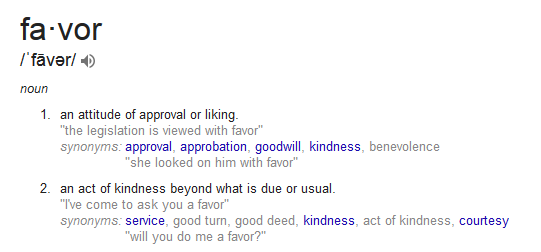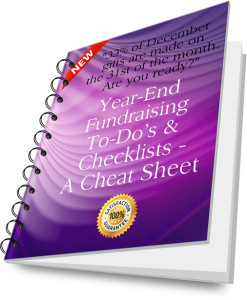 You asked a bunch of folks to give a year ago. Some did.
You asked a bunch of folks to give a year ago. Some did.
You thanked them. Once. Maybe twice.
Now you want to ask them to give again this year.
What’s wrong with this picture?
Too often nonprofits ask once; then assume folks who’ve made the decision to give will continue to do so. This is similar to retailers thinking once someone has bought from them they’ll automatically do so again.
Not true in either case.
You’ve got to sell again and again. Time marches on. Memories are short, and circumstances change. It’s a matter of “What have you done for me lately?”
If you thank folks once, and then wait a whole year to communicate with them again, folks are not going to be ‘ready’ to repeat their giving without going through a whole cycle of hesitations.
Uh, oh. Have you fallen down on your stewardship this past year? Is it too late?
Maybe not!
Use Psychology to Pre-Suade Donors to Give
Before we get to the really good news, let’s take a look at some of the science underlying your donor’s decision-making process when confronted with an opportunity to make a philanthropic gift.
In a guest article for Bloomerang, 3 Ways to Remove Psychological Barriers to Philanthropic Giving, I discussed a number of psychological hurdles you must jump over in order to persuade your donor to give. Or to give again.
You see, whenever a prospective donor contemplates making a gift to you, they ask themselves (consciously or unconsciously) what the risk is in so doing. And, in their minds, they experience what I imagine as a “Should I, or shouldn’t I?” tango.
Naturally risk averse, folks go through a series of dance steps before coming to a decision. Much of their consideration boils down to this:
If I give/don’t give, what do I have to lose?
vs.
If I give/don’t give, what do I have to gain?
And much psychological research from experts like Paul Slovic and Daniel Kahneman has shown fear of loss weighs heavier than hope of gain.
What does this mean for you as a fundraiser?
Ramp Down Risks Associated with Giving
It’s your job to do whatever is in your power to ramp down risk for your potential supporter. How can you circumvent the natural donor thought process? The one that:
- Causes them to fear making a mistake that will lead to some sort of loss?
- Gets in the way of enabling them to feel all the positive benefits that come from engaging in philanthropy?
- Causes folks to screech to a halt before hitting the “donate” button?
One way is showing folks they’ve little to lose and much to gain.
I suggested some strategies in the guest article to which I alluded earlier, which I’ll quickly summarize.
- TESTIMONIALS: Showcase testimonials from trusted authorities (board and community leaders, celebrities, politicians) that act as a short-cut for your donor’s decision making. If they trust the quoted authority, they’re likely to trust you too.
- YOUR UNIQUENESS: Showcase what you do differently, and better, than anyone else. Finding and sharing your own uniqueness creates clarity that overcomes the objection that giving to you may cause loss of an opportunity to give to a better cause.
- ONGOING STEWARDSHIP: Engage frequently with gratitude and gifts of content to assure your donor gains continuous enjoyment out of their investment and affiliation with you, essentially predisposing them to say “yes” when you next ask. Woo folks with appealing communications and you’ll find they become less risk averse over time.
I’d like to amplify today on the ongoing stewardship strategy, with a suggestion I think you’ll like. It’s not too late to predispose your donor to say yes this year!
You Can “Pre-Sell” Donors Up to the Moment before You Ask
The guru of influence himself, Robert Cialdini, released another groundbreaking book in 2016, Pre-Suasion: A Revolutionary Way to Influence and Persuade, suggesting a 7th principle of influence and persuasion. He calls it “pre-suasion.” And, by the way, if you’re unfamiliar with Cialdini’s seminal book, Influence: The Psychology of Persuasion, it’s a foundational text about why people say “yes” and how to apply psychology when persuading others. Sounds pretty pertinent to fundraising, no?
Yes! Which is why I’ve written before about Cialdini’s six principles of influence and persuasion. I’ve taken them to heart when it comes to asking people for philanthropic gifts, and I hope you will too. And, wonder of wonders, after nearly 30 years he took the science a bit further to show how you can pre-suade people to say “yes” in advance of asking them!
This means that even if you haven’t done the best job you could stewarding your donors throughout the course of the past year, all is not lost.
Let’s get right to the new strategy, because it’s a paradigm changer.
What Cialdini has done is added a new dimension, time, to the science of persuasion.
Cialdini explains in an interview with Roger Dooley, author of Brainfluence:
“Time really comes down to the moment before we deliver our message. There is what I’m calling “privileged moments” when if we know what to put in that moment before we deliver our message to ready the individual, to make that person more receptive to what we’re about to say, we gain a new dimension of leverage over the communication process as a result.”
To me, using time takes one of Cialdini’s original six key influence principles, “reciprocity,” to another level. We know human beings often feel obligated to return favors, even if they are unasked for. This is the ultimate reason why great customer service has such a fantastic ROI, and the top reason customers become repeat customers. Psychologist Norbert Schwarz found in a 1987 study that it doesn’t take much to start the process of reciprocity; even the smallest of favors allow goodwill to be bought with customers, increasing loyalty and retention.
Hence, my eternal recommendation that you make someone on your staff responsible for donor service and that you make stewardship ongoing.
Here’s what’s new: It turns out that in the “what have you done for me lately?” equation, recency is key.
The research centers on the giving and receiving of “favors,” and on the timing of so doing.
While I’ve long suggested that if you want gifts you must give them, Cialdini’s research suggests you will reap the greatest benefit from your gift giving within a relatively short time frame. After a favor has been done, in that privileged moment, the recipient values it most highly. As time goes by, the value associated with what was received declines.
So… what should you do immediately before asking someone to make a gift in order to predispose them to be receptive?
Do Your Prospective Donors a Meaningful Favor
Now we’re into the nitty gritty of your pre-suasion strategy. Even if your donor stewardship up until today has been less than inspiring, you can still stack the deck in your favor!
Ah, there’s that “favor” word again. So what kind of favor should you do?
According to Cialdini’s research, the favor you give must be:
- unexpected,
- not part of what’s naturally done in exchanges between people, and
- customized or personalized to that individual’s needs and challenges.
If you can accomplish this, per Cialdini, you now have arranged for the recipient to want to give back to you at the highest possible levels.
Let me show you how this worked in the retail world.
EXPERIMENT #1 – Fast Food Restaurant
Researchers set up in a fast food restaurant. As people came in, the manager greeted each one-third of people differently:
— The first third were warmly greeted; then ushered over to the counter where they could order food.
— The second third were given a small gift, a nice keyring, when they came in; then ushered to the counter where they ordered 12% more food than those who were simply greeted warmly. Because they were given something, they wanted to give back.
— The third cohort were given a cup of yogurt; then ushered to the counter where they purchased 24% more than those who were just warmly greeted. Because they were given the most meaningful favor for folks coming into a restaurant, free food, they purchased double what those who were given a less meaningful gift.
How Do You Translate Pre-Suasion to Your Fundraising Appeal?
When reading the research, I immediately thought of front-end premiums. I’ve always hated those with my gut, but also always knew they had to work or direct mail agencies wouldn’t keep recommending them.
Here’s the twist, however: The premium must be perceived as meaningful to the recipient. If you enclose a penny, maybe that won’t do the trick. Because it doesn’t seem a fair exchange. And it’s neither customized nor personalized. Note cards? A calendar? Maybe a bit more customized. Address labels? Now we’re getting into more personalized territory. So, maybe yes.
But what about the appeal you send to your ongoing donors? Will they find such tactics meaningful, or be annoyed? I can’t answer that, but I do think it’s worth testing.
You might also consider a different type of premium “gift” that’s less tangible, and perhaps even less expected. It could be an invitation to an upcoming event that you extend to everyone who donates (arts organizations do this a lot for “openings” – even including the RSVP box on the remit form). It could be an intangible gift like a recipe (I once sent a challah recipe from a Russian refugee in an appeal we dropped right before the Jewish High Holydays; we received a very high return).
EXPERIMENT #2 — Hotel
In Cialdini’s book, he cites the example of hotel guests who were 47% more likely to reuse their towels if they were told the hotel had already made a contribution in their name to an environmental charity than if the contribution occurred only after re-use actually happened.
TIP: What if you told your donors a tribute contribution had already been made in their name by another donor (a twist on the traditional “challenge grant” that doesn’t require you to secure quite as large of a gift)?
So far so good.
But you still can blow it, per Cialdini, if you don’t reinforce for the donor how meaningful their return of the favor at some point in the future will be.
Coming Up
We’ll take a look at how to cement the likelihood your favor is returned, as well as explore some types of favors nonprofits can afford to offer that are likely to be perceived as valuable, in Part 2 of this two-article series — coming next week.
In the meantime, I’d love to know what you think about these ideas thus far. Have you tried this? Do you have some thoughts as to how you might try this?
Want More to Rock Year-End Fundraising?
Get my Year-End Fundraising Solution Kit. It’s filled with tips and checklists to assure you don’t miss a trick. Everything you need to assure you get, and keep, the most donations possible this year.
Not satisfied? All Clairification products come with a 30-day, no-questions-asked money-back guarantee. If you’re not happy, I’m not happy.
Photo by Preillumination SeTh on Unsplash






